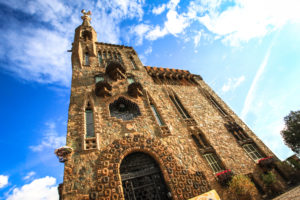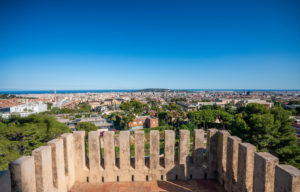By: Ferran Garcés

A couple of weeks ago, we talked about Gaudí’s peculiar conception of rooftops. Torre Bellesguard is a good example of this due to the great variety of structural and decorative elements that shape it, such as attics in the shape of a dragon. However, the Bellesguard rooftop is also special for the panoramic view of the city that can be seen from it, including both the sea and the mountains. In fact, Bellesguard means precisely that, “beautiful views.”
Bernardí Martorell, a disciple of Gaudí, built two buildings very close in space and time to Torre Bellesguard. Both stand out in the “beautiful views” from the rooftop. Last week we explained the history of one of them, the Royal Monastery of Santa María de Valldonzella (1912-1923). Today we will talk about the second, the Convent of the Redeemer (1911-1926).
Currently, the convent is part of the facilities of Abat Oliba CEU University, built between 1993 and 1995, according to the project and direction of the architect Miguel Ángel Armengou. The same architect, shortly after, was in charge of the restoration of Bernardí Martorell’s church and its transformation into an auditorium. However, like Gaudí’s Torre Bellesguard, the history of this building also goes much further back in time. Recent excavations confirm the area’s connection with the castle of Martin I the Humane in the early 15th century.
First, castle and chapel
Martin I the Humane, the last monarch of the House of Barcelona, resided in the old Bellesguard castle from June 1409 until May 12, 1410. The chapel of this castle was located where the Convent of the Redeemer now stands. On September 17, 1409, Martin I married his second wife, Margaret of Prades, in this chapel. The ceremony was attended by three illustrious personalities of the time: Benedict XIII, better known as Pope Luna, Vincent Ferrer, future saint, and his brother Boniface. A painting, preserved in the Curia Iuris of Abat Oliba CEU University, recreates this moment. The royal couple lived at Bellesguard until mid-May 1410, when they moved to the old Monastery of Valldonzella, where the king died without a successor.

After, asylum and auditorium
The medieval monastery of Valldonzella was destroyed during the Reapers’ War in the 17th century, and the old Bellesguard castle was in very poor condition by the late 19th century. The land where the few surviving ruins could be seen was owned by Joan Baptista Grau Vallespinós, bishop of Astorga and friend of Gaudí.
In 1895, the Oblate Sisters of the Most Holy Redeemer rented part of this land to establish the Saint Alphonsus asylum for marginalized women. The other part was purchased by the Figueras family in 1900. In this area, Antoni Gaudí built the current Torre Bellesguard, and shortly after, on the asylum site, his disciple Bernardí Martorell built the Convent of the Redeemer, which now houses the auditorium of Abat Oliba University, and not far away, the Royal Monastery of Santa María de Valldonzella. Come to learn more about its history and enjoy the “beautiful views” from the rooftop, where you can admire these three buildings that recall the final moments of the last king of the House of Barcelona.
Notes
(1) For more detailed information about the interventions carried out, readers can consult the website of the Urban Information Portal of the Barcelona City Council: link to Heritage Catalogue 2204.
(2) Editorial (01/20/2023), “Archaeology confirms the link with Martin the Humane”, Abat Oliba CEU University website.
(3) Exceptionally, in the early 18th century, King Martin’s castle experienced a second golden age thanks to Joan Bonaventura Ferrer de Gualbes y Copons, a descendant of the first warden of Bellesguard during the monarch’s time. There, the anti-Bourbon conspiracy that led to the Catalan uprising against Philip V was brewed. The tower also became a meeting point for scholars who gathered around the Academy of the Distrustful, the seed of the current Academy of Good Letters of Barcelona.
(4) Vall i Comaposada, Josep M. (2014), Bellesguard. De la residència de Martí l’Humà a la Torre de Gaudí, Duxelm editorial, Barcelona, p. 92-102. En aquest enllaç es poden veure fotos antigues de la zona i els edificis esmentats.




